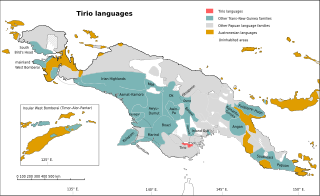
The Trans-Fly–Bulaka RiverakaSouth-Central Papuan languages form a hypothetical family of Papuan languages. They include many of the languages west of the Fly River in southern Papua New Guinea into southern Indonesian West Papua, plus a pair of languages on the Bulaka River a hundred km further west.

The Kiwaian languages form a language family of New Guinea. They are a dialect cluster of half a dozen closely related languages. They are grammatically divergent from the Trans–New Guinea languages, and typically have singular, dual, trial, and plural pronouns.

The Tirio languages are a family of Trans–New Guinea languages in the classification of Malcolm Ross. The Tirio languages have about 40% of their lexicon in common.

The Gogodala–Suki or Suki – Aramia River languages are a small language family of Papua New Guinea, spoken in the region of the Aramia River.

The Yam languages, also known as the Morehead River languages, are a family of Papuan languages. They include many of the languages south and west of the Fly River in Papua New Guinea and Indonesian West Papua.
The Trans-Fly languages are a small family of Papuan languages proposed by Timothy Usher, that are spoken in the region of the Fly River.

Morori is a moribund Papuan language of the Kolopom branch of the Trans–New Guinea family. It is separated from the other Kolopom languages by the intrusive Marind family. All speakers use Papuan Malay or Indonesian as L2, and many know Marind.
Ngkolmpu Kanum, or Ngkontar, is part of a dialect chain in the Yam family spoken by the Kanum people of New Guinea. The Ngkâlmpw (Ngkontar) and moribund Bädi varieties have limited mutual intelligibility may be considered distinct languages.
Wipi, also known as Gidra, Jibu or Oriomo, is a Papuan language of New Guinea. It is a member of the Eastern Trans-Fly family, the other languages of this family being Gizrra, Meriam Mir and Bine. The family has influenced the neighbouring Kiwai language as well as Kalau Lagau Ya.

Idi is a Pahoturi language spoken in Western Province, Papua New Guinea. The so-called Pahoturi dialects form a dialect chain with Idi proper at one end and Agob proper at the other.
Yei is a Papuan language of New Guinea. The Upper and Lower Yey dialects are only mutually intelligible with difficulty.
Riantana, or Kimaam, is a language spoken on Yos Sudarso Island in Papua province, Indonesia.

Morehead Rural LLG is a local-level government (LLG) of Western Province, Papua New Guinea. Merauke Regency, Indonesia is located adjacently to the west. Yam, Pahoturi, and Anim languages are spoken in the LLG.

Oriomo-Bituri Rural LLG is a local-level government (LLG) of Western Province, Papua New Guinea. Eastern Trans-Fly languages are spoken in the LLG.
Taeme is a Pahoturi language spoken in Kondobol ward, northeast Morehead Rural LLG, Western Province, Papua New Guinea. It is spoken by 834 people in Taeme village, Kondobol ward, Morehead Rural LLG.
Tamer (Tämer) is a Yam language of Yanggandur in southeast Merauke Regency, Indonesia. It forms a dialect continuum with Smerki (Smärki), and indeed goes by that name.
Smerki is a Yam language spoken in Rawu Biru, Tomer, Tomerau, and Yakiw in southeast Merauke Regency, Indonesia. Bârkâli (Barkari) and Smärki may be distinct enough to count as separate languages. The Tamer language is closely related.
Nggarna (Ngar), or Sota, is a Yam language of in the village of Sota in Merauke Regency, Indonesia. Located in western which borders with Morehead Rural LLG, Western Province, Papua New Guinea. Despite identifying as Kanum, the language is closer to Rema across the border in Indonesia than it is to other Kanum languages of Papua New Guinea.
The Bensbach River is a river in southwestern Papua New Guinea. It is located just to the east of the Maro River in Merauke Regency, Indonesia, and just to the west of the Morehead River in Papua New Guinea.
The Morehead River is a river in southwestern Papua New Guinea. It is located just to the east of the Bensbach River, and to the west of the Fly River. The river flows through the Trans-Fly savanna and grasslands.








